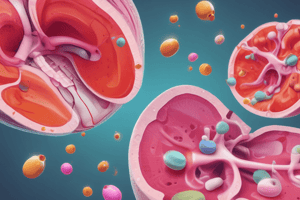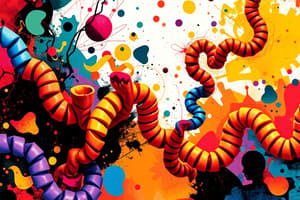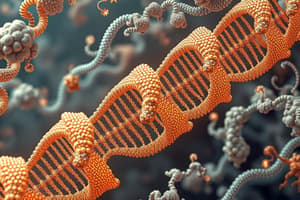Podcast
Questions and Answers
What is a typical amount of protein consumed in the U.S. diet per day?
What is a typical amount of protein consumed in the U.S. diet per day?
- 200 g/day
- 100 g/day (correct)
- 300 g/day
- 50 g/day
Which statement correctly describes the amino acid pool in healthy individuals?
Which statement correctly describes the amino acid pool in healthy individuals?
- It is primarily derived from dietary sources only.
- It remains constant over time. (correct)
- It is maintained in a state of flux.
- It is continuously increasing in size.
All of the following are routes for depleting the amino acid pool except:
All of the following are routes for depleting the amino acid pool except:
- Synthesis of body protein
- Conversion of amino acids to glucose
- Amino acids as precursors for small molecules
- Conversion of amino acids to vitamins (correct)
What is typically the largest source of amino acids used to maintain the amino acid pool?
What is typically the largest source of amino acids used to maintain the amino acid pool?
Which of the following processes helps to maintain the amino acid pool?
Which of the following processes helps to maintain the amino acid pool?
In the context of protein turnover, what portion of body protein is typically synthesized and degraded daily?
In the context of protein turnover, what portion of body protein is typically synthesized and degraded daily?
Which of the following options is NOT a function of the amino acid pool?
Which of the following options is NOT a function of the amino acid pool?
Which small molecules can amino acids serve as precursors for?
Which small molecules can amino acids serve as precursors for?
What is the primary purpose of urea synthesis in the body?
What is the primary purpose of urea synthesis in the body?
Which compound is not directly involved in the urea cycle?
Which compound is not directly involved in the urea cycle?
Which metabolic pathways can the carbon skeletons of α-ketoacids be converted into?
Which metabolic pathways can the carbon skeletons of α-ketoacids be converted into?
During amino acid catabolism, what is the role of ammonia?
During amino acid catabolism, what is the role of ammonia?
Which of the following compounds is a product of urea biosynthesis?
Which of the following compounds is a product of urea biosynthesis?
What is primarily the fate of free ammonia in the body?
What is primarily the fate of free ammonia in the body?
Which amino acid is notably associated with the synthesis of urea?
Which amino acid is notably associated with the synthesis of urea?
Which type of compounds are primarily processed through the urea cycle?
Which type of compounds are primarily processed through the urea cycle?
What is the primary function of D-Amino acid oxidase (DAO)?
What is the primary function of D-Amino acid oxidase (DAO)?
Which compound is produced by glutamine synthetase when ammonia combines with glutamate?
Which compound is produced by glutamine synthetase when ammonia combines with glutamate?
How does alanine contribute to ammonia transport to the liver?
How does alanine contribute to ammonia transport to the liver?
What enzyme cleaves glutamine in the liver to produce glutamate and free ammonia?
What enzyme cleaves glutamine in the liver to produce glutamate and free ammonia?
Which condition has been associated with increased activity of D-amino acid oxidase?
Which condition has been associated with increased activity of D-amino acid oxidase?
What role do α-keto acids play in amino acid metabolism?
What role do α-keto acids play in amino acid metabolism?
What happens to alanine once it reaches the liver?
What happens to alanine once it reaches the liver?
What is the result of elevated glutamate levels in the liver after protein ingestion?
What is the result of elevated glutamate levels in the liver after protein ingestion?
How is ammonia primarily transported in the blood from peripheral tissues to the liver?
How is ammonia primarily transported in the blood from peripheral tissues to the liver?
Which molecule acts as an allosteric inhibitor of glutamate dehydrogenase?
Which molecule acts as an allosteric inhibitor of glutamate dehydrogenase?
What is the role of glutamate dehydrogenase in amino acid metabolism?
What is the role of glutamate dehydrogenase in amino acid metabolism?
Which reaction is facilitated by low energy levels in a cell?
Which reaction is facilitated by low energy levels in a cell?
What type of amino acids are not used in the synthesis of mammalian proteins?
What type of amino acids are not used in the synthesis of mammalian proteins?
Which of the following statements about D-Amino acids is true?
Which of the following statements about D-Amino acids is true?
What is the function of aminotransferases in amino acid metabolism?
What is the function of aminotransferases in amino acid metabolism?
What mechanism allows amino acids to be generated from α-keto acids?
What mechanism allows amino acids to be generated from α-keto acids?
What is the primary source of ammonia in Western diets?
What is the primary source of ammonia in Western diets?
Which of the following reactions is involved in the production of ammonia during transdeamination?
Which of the following reactions is involved in the production of ammonia during transdeamination?
What role does renal glutaminase play in ammonia production?
What role does renal glutaminase play in ammonia production?
How does the body maintain low levels of circulating ammonia?
How does the body maintain low levels of circulating ammonia?
What happens to urea after it is produced in the liver?
What happens to urea after it is produced in the liver?
Which process produces an important amount of ammonia from dietary sources?
Which process produces an important amount of ammonia from dietary sources?
Which enzyme is responsible for cleaving urea into CO2 and NH3 in the intestine?
Which enzyme is responsible for cleaving urea into CO2 and NH3 in the intestine?
What is ammonia primarily excreted as after being generated in the kidneys?
What is ammonia primarily excreted as after being generated in the kidneys?
Which of the following is an additional source of ammonia besides amino acids?
Which of the following is an additional source of ammonia besides amino acids?
In patients with kidney failure, how does elevated plasma urea levels affect the gut?
In patients with kidney failure, how does elevated plasma urea levels affect the gut?
What important balance does ammonia excretion through the kidneys help maintain?
What important balance does ammonia excretion through the kidneys help maintain?
What is one consequence of the intestinal action of urease in kidney failure patients?
What is one consequence of the intestinal action of urease in kidney failure patients?
What is the stoichiometric result of the urea cycle?
What is the stoichiometric result of the urea cycle?
Which nitrogen sources contribute to the formation of urea?
Which nitrogen sources contribute to the formation of urea?
What role does neomycin play in ammonia production in patients with kidney issues?
What role does neomycin play in ammonia production in patients with kidney issues?
What is the result of the irreversible nature of urea synthesis?
What is the result of the irreversible nature of urea synthesis?
Flashcards
Urea synthesis
Urea synthesis
The process of creating urea, the primary method for excreting nitrogenous waste.
Amino acid catabolism
Amino acid catabolism
The breakdown of amino acids to obtain energy.
Nitrogen disposal
Nitrogen disposal
The removal of nitrogen from the body primarily via urea synthesis.
Carbon skeletons
Carbon skeletons
Signup and view all the flashcards
Metabolic pathways
Metabolic pathways
Signup and view all the flashcards
α-ketoacids
α-ketoacids
Signup and view all the flashcards
Energy production
Energy production
Signup and view all the flashcards
Central pathways
Central pathways
Signup and view all the flashcards
Amino acid pool size
Amino acid pool size
Signup and view all the flashcards
Dietary protein variation
Dietary protein variation
Signup and view all the flashcards
Amino acid pool depletion routes
Amino acid pool depletion routes
Signup and view all the flashcards
Protein turnover
Protein turnover
Signup and view all the flashcards
Nitrogen balance (steady state)
Nitrogen balance (steady state)
Signup and view all the flashcards
Body protein synthesis
Body protein synthesis
Signup and view all the flashcards
Essential amino acid precursor usage
Essential amino acid precursor usage
Signup and view all the flashcards
Amino acid pool's role
Amino acid pool's role
Signup and view all the flashcards
Transamination
Transamination
Signup and view all the flashcards
Reductive Amination
Reductive Amination
Signup and view all the flashcards
Glutamate Dehydrogenase
Glutamate Dehydrogenase
Signup and view all the flashcards
What happens to glutamate levels after protein intake?
What happens to glutamate levels after protein intake?
Signup and view all the flashcards
How does energy level affect amino acid degradation?
How does energy level affect amino acid degradation?
Signup and view all the flashcards
What is GTP's role in glutamate metabolism?
What is GTP's role in glutamate metabolism?
Signup and view all the flashcards
What is ADP's role in glutamate metabolism?
What is ADP's role in glutamate metabolism?
Signup and view all the flashcards
D-Amino acid oxidase
D-Amino acid oxidase
Signup and view all the flashcards
Urea's Journey
Urea's Journey
Signup and view all the flashcards
Ammonia's Fate
Ammonia's Fate
Signup and view all the flashcards
Kidney Failure and Ammonia
Kidney Failure and Ammonia
Signup and view all the flashcards
Neomycin for Ammonia
Neomycin for Ammonia
Signup and view all the flashcards
Urea Cycle's Stoichiometry
Urea Cycle's Stoichiometry
Signup and view all the flashcards
Urea Synthesis's Energy
Urea Synthesis's Energy
Signup and view all the flashcards
Urea's Nitrogen Sources
Urea's Nitrogen Sources
Signup and view all the flashcards
Nitrogen Disposal Importance
Nitrogen Disposal Importance
Signup and view all the flashcards
Ammonia's main source
Ammonia's main source
Signup and view all the flashcards
Glutamine's role
Glutamine's role
Signup and view all the flashcards
Glutamine Synthesis
Glutamine Synthesis
Signup and view all the flashcards
Renal Glutaminase
Renal Glutaminase
Signup and view all the flashcards
Intestinal Glutaminase
Intestinal Glutaminase
Signup and view all the flashcards
Ammonia disposal
Ammonia disposal
Signup and view all the flashcards
Why is ammonia disposal important?
Why is ammonia disposal important?
Signup and view all the flashcards
D-Amino Acid Oxidase (DAO)
D-Amino Acid Oxidase (DAO)
Signup and view all the flashcards
Ammonia (NH3) Transport
Ammonia (NH3) Transport
Signup and view all the flashcards
Glutaminase
Glutaminase
Signup and view all the flashcards
Alanine
Alanine
Signup and view all the flashcards
Transamination in Ammonia Transport
Transamination in Ammonia Transport
Signup and view all the flashcards
Pyruvate
Pyruvate
Signup and view all the flashcards
Study Notes
Amino Acid Disposal of Nitrogen
- Amino acids are not stored by the body, requiring intake, synthesis, or breakdown of existing proteins.
- Excess amino acids are rapidly broken down.
- The first stage involves removing the α-amino groups, which forms ammonia and a-keto acids.
- A significant portion of the ammonia is used to synthesize urea.
- The second stage of amino acid catabolism involves breaking down the carbon skeletons of a-keto acids into common energy-producing metabolic pathways.
Overall Nitrogen Metabolism
- Amino acid catabolism is part of a larger nitrogen-containing molecule metabolism.
- Nitrogen intake mostly comes from amino acids in dietary protein.
- Nitrogen excretion happens mostly through urea, ammonia, and other products from amino acid metabolism.
- Body protein functions in transformations via the amino acid pool and protein turnover.
Protein Turnover
- Protein turnover is the simultaneous synthesis and degradation of protein molecules.
- In healthy adults, the total amount of protein remains constant since protein synthesis offsets the rate of protein degradation.
- The rate of protein turnover varies widely for different proteins.
- Short-lived proteins are rapidly degraded, while long-lived proteins (structural proteins) have longer half-lives.
- Protein degradation is done by two major enzyme systems: the ATP-dependent ubiquitin-proteasome system and the ATP-independent degradative enzyme system of the lysosomes.
Amino Acid Pool
- Free amino acids are present throughout the body (cells, blood, extracellular fluids).
- The amino acid pool includes amino acids from protein degradation, dietary protein, and synthesis of nonessential amino acids.
- These amino acids are used for body protein synthesis and consumed for glucose, glycogen, fatty acids, or ketone bodies.
- In healthy individuals, the intake and output of the amino acid pool are balanced, maintaining a constant amount in steady state.
Digestion of Dietary Proteins
- Protein digestion begins in the stomach with gastric secretions.
- Hydrochloric acid denatures proteins.
- Pepsinogen is converted to pepsin, which breaks proteins into smaller peptides and free amino acids.
- Pancreatic enzymes enter the small intestine and continue cleaving large polypeptides into oligopeptides and amino acids.
- Different enzymes (trypsin, chymotrypsin, elastase, and carboxypeptidases) have unique specificities for amino acid R-groups to cleave peptide bonds.
- Enteropeptidase activates trypsinogen to trypsin, initiating a cascade of zymogen activation.
- Abnormalities in pancreatic secretion can lead to incomplete digestion and absorption of fats and proteins, resulting in steatorrhea and undigested protein in feces.
Transport of Amino Acids into Cells
- Free amino acids enter cells by Sodium (Na+)-linked secondary transport systems in the apical membrane.
- Di- and tripeptides enter cells via H+-linked transport systems, which hydrolyze the peptides into amino acids in the cell cytoplasm.
- Free amino acids are released into the portal system via facilitated diffusion.
- Branched-chain amino acids are not metabolized by the liver but travel mostly to muscle.
Removal of Nitrogen from Amino Acids
- The presence of the α-amino group prevents oxidative breakdown and is essential for amino acid catabolism.
- Transamination is the first step, where the α-amino group is transferred to α-ketoglutarate, forming glutamate and an α-keto acid.
- Oxidative deamination of glutamate releases ammonia (NH3), which can be used in urea synthesis.
- Aminotransferases (formerly called transaminases) catalyze the transfer of the amino groups to form glutamate, which then can be oxidatively deaminated.
- Alanine Aminotransferase (ALT) and Aspartate Aminotransferase (AST) are two crucial aminotransferases.
Urea Cycle
- Urea is the major nitrogenous waste product in mammals.
- The urea cycle occurs in the liver, with the first steps occurring in the mitochondria and the remaining steps in the cytosol.
- Carbamoyl phosphate synthetase I is the rate-limiting step in the urea cycle, requiring ATP for the synthesis of carbamoyl phosphate.
- Ornithine transcarbamoylase, argininosuccinate synthetase, argininosuccinate lyase, and arginase are the other enzymes involved in the cycle.
- Urea is transported to the kidneys for excretion in the urine.
Metabolism of Ammonia
- Ammonia is a major byproduct of amino acid metabolism and is toxic to the central nervous system (CNS).
- The liver is the primary organ for ammonia disposal through urea cycle synthesis.
- Glutamine is an important non-toxic transport form for ammonia.
- Glutamine synthetase synthesizes glutamine from glutamate.
- Glutaminase catalyzes the breakdown of glutamine into glutamate and ammonia.
- Urea synthesis in the liver excretes a significant portion of nitrogenous waste.
Metabolic Defects in Amino Acid Metabolism
- Inborn errors of amino acid metabolism are caused by mutant genes, usually affecting enzymes.
- These defects can result in the loss of enzyme activity or a partial deficiency.
- Without treatment, some defects result in mental retardation or developmental issues due to harmful accumulation of metabolites.
- Conditions like phenylketonuria (PKU), maple syrup urine disease (MSUD), albinism, and homocystinuria are examples of metabolic defects in amino acid metabolism.
Studying That Suits You
Use AI to generate personalized quizzes and flashcards to suit your learning preferences.




